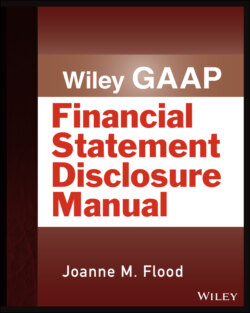Читать книгу Wiley GAAP: Financial Statement Disclosure Manual - Joanne M. Flood - Страница 18
ASC 205‐30, Liquidation Basis of Accounting
ОглавлениеDetermining When to Apply the Liquidation Basis of Accounting Guidance requires financial statements to be prepared using the liquidation basis of accounting when liquidation is imminent. (ASC 205‐30‐25‐1) For example, if a calendar year entity determines on March 1 that liquidation is imminent, it must calculate net asset balances as of March 1 and present a statement of net assets as of its March 31 quarterly financial statements.
Liquidation is considered imminent when:
A plan for liquidation is approved by the person or persons with the authority to make such a plan effective, and the likelihood is remote that the execution of the plan will be blocked by other parties or the entity will return from liquidation, or
A plan for liquidation is being imposed by other forces, such as involuntary bankruptcy, and the likelihood is remote that the entity will return from liquidation.(ASC 205‐30‐25‐2)
Measuring Assets and Liabilities The financial statements prepared under the liquidation basis of accounting are intended to “report the amount of cash or other consideration that an investor might reasonably be expected to receive after liquidation.” (ASU 2013‐07, BC13) Assets should be measured at the amount the entity expects to collect upon sale. This may or may not be fair value because fair value assumes an orderly sale. (ASC 205‐30‐30‐1) Therefore, an asset sale during a liquidation may or may not approximate fair value. The following should also be considered:
Previously unrecognized assets, such as internally generated trademarks and patents, should be recognized. These items may be presented in the aggregate, but must separately record any expected disposal or selling costs. Expected selling costs should be included in the accrual of estimated disposal costs. (ASC 205‐30‐25‐4)
Liabilities should be recognized in accordance with relevant guidance in other Topics. However, some estimates, like timing of payments, may change and should be recorded. In addition, an entity should not assume that it will legally be released from its obligations. (ASC 205‐30‐30‐2)
Estimated costs to dispose of assets or other items to be sold in liquidation should be accrued, but discount provisions should not be applied (ASC 205‐30‐25‐6 and 205‐30‐30‐3). Those costs should be presented in the aggregate, but separate from the related assets or items. If and when it has a reasonable basis for estimation, the entity should accrue costs and income expected to be incurred or earned through the end of the liquidation. (ASC 205‐30‐25‐6 and 7)
Income expected to be collected during liquidation should be accrued, but the entity should exercise care in making that estimate.
The entity must estimate the costs that it will incur during liquidation if it has a basis for the estimation.
Presentation An entity using the liquidation basis of accounting must apply it prospectively from the day the liquidation becomes imminent and change the form of its financial statements to:
A statement of net assets in liquidation, as of the end of the reporting period, that presents the entity's net assets available for distribution to investors, and
A statement of changes in net assets in liquidation that present only changes in net assets occurring during the period since liquidation became imminent.(ASC 205‐30‐45‐1 and 45‐2 and ASC 205‐30‐20)
While the standards do not require a statement of net assets as of the date the liquidation becomes imminent, that information is necessary to prepare a statement of changes in net assets for the first period in which liquidation becomes imminent. (ASU 2013‐07, BC 17)
Disclosure The entity must disclose information required by other Topics relevant to understanding the statement of net assets in liquidation and statement of changes in net assets in liquidation, informing readers about:
The amount of cash or other consideration that the entity expects to collect and
The amount that the entity is obligated or expects to be obligated to pay during the course of liquidation.(FASB ASC 205‐30‐50‐1)The entity must also disclose all of the following for financial statements using the liquidation basis of accounting:That the financial statements are prepared using the liquidation basis of accounting.The facts and circumstances surrounding the adoption of the liquidation basis of accounting and the entity's determination that liquidation is imminent.The entity's plan for liquidation, including a description of:The manner by which it plans to dispose of its assets.Other items it expects to sell that it had not previously recognized as assets (for example, trademarks).The manner by which it plans to settle its liabilities.The expected date by which the entity expects to complete its liquidation.
Methods and significant assumptions used to measure assets and liabilities.
Any subsequent changes to those methods and assumptions.
The type and amount of costs and income accrued in the statement of net assets in liquidation.
The period over which those costs are expected to be paid or income earned.(FASB ASC 205‐30‐50‐2)
The entity should also consider information that would help the reader to better understand the proceedings and where to obtain additional information, including:
Which subsidiaries are included in the filing
The bankruptcy jurisdiction
Key hearings
Agreements reached with creditors
The status of any debtor‐in‐possession and exit financings
It should be noted that disclosures, such as debt covenant violations, required by other Topics may be affected by the filing.
